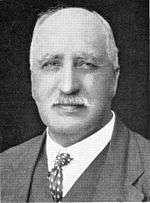South African Class MJ 2-6-6-0
|
SAR Class MJ no. 1651, c. 1914 | |||||||||||||||||||||||||||||||||||||||||||||||||||||||||||||||||||||||||||||||||||||||||||||||||||||||||||||||||
| |||||||||||||||||||||||||||||||||||||||||||||||||||||||||||||||||||||||||||||||||||||||||||||||||||||||||||||||||
| |||||||||||||||||||||||||||||||||||||||||||||||||||||||||||||||||||||||||||||||||||||||||||||||||||||||||||||||||
| |||||||||||||||||||||||||||||||||||||||||||||||||||||||||||||||||||||||||||||||||||||||||||||||||||||||||||||||||
| |||||||||||||||||||||||||||||||||||||||||||||||||||||||||||||||||||||||||||||||||||||||||||||||||||||||||||||||||
The South African Railways Class MJ 2-6-6-0 of 1914 was a steam locomotive.
Between 1914 and 1921, the South African Railways placed eighteen Class MJ Mallet articulated compound steam locomotives with a 2-6-6-0 wheel arrangement in branchline service.[1][2][3][4]
Manufacturers
The Class MJ 2-6-6-0 Mallet articulated compound steam locomotive was designed by D.A. Hendrie, Chief Mechanical Engineer (CME) of the South African Railways (SAR) from 1910 to 1922, to meet the need for engines with a higher tractive effort to cope with heavy traffic on branchlines.[1][2][4]

Ten of these branchline locomotives were ordered from Maffei of Munich but, as a result of the outbreak of the First World War, only two could be delivered from Germany in 1914, numbered 1651 and 1652, with works numbers 3452 and 3453. The order for the remaining eight was then transferred to the North British Locomotive Company (NBL) in Scotland, who delivered them in 1917 and 1918, numbered in the range from 1653 to 1660.[1][2][4][5]
The known works numbers for the eight NBL-built locomotives are recorded as 21248 to 21255. However, these numbers are in conflict with the NBL works numbers 21246 to 21275, which were allocated to thirty 2-8-2T locomotives, numbered 5381 to 5410 and built by NBL in 1917 for the Paris-Orleans railway in France.[1][5][6]
After cessation of hostilities in 1918, Maffei approached the SAR and requested that the balance of the original order, which had been built in 1914 but could not be delivered because of the war, also be accepted. These eight locomotives were subsequently delivered in 1921, numbered in the range from 1674 to 1681, with works numbers 3454 to 3461.[1][2][4][7]
Characteristics
The locomotives had Walschaerts valve gear and were superheated, using the Schmidt type superheater. Unlike most of the other SAR Mallet classes, which had round-topped fireboxes, the Class MJ had Belpaire fireboxes. The four cylinders were arranged outside the 4 inches (102 millimetres) thick bar frames.[1][2][4]
The locomotives were delivered with Type MP1 tenders with a coal capacity of 10 long tons (10.2 tonnes) and a water capacity of 4,250 imperial gallons (19,300 litres). The same tender was used by altogether fifteen other locomotive Classes.[2][3]
Reboilering
During 1939, while W.A.J. Day was the CME of the SAR, the Classes MJ and MJ1 were modified slightly to be reboilered with the same standard boiler.[2]
Service
With its light axle loading, the Class MJ was intended for branchline working. Most of them were placed in service in the Eastern Cape, but four went to Natal and are believed to have worked on the Eshowe branchline. They gave satisfactory service on the Cape Eastern System, where the moderate speeds required on the sections over which they worked, assisted them to give reasonably good results.[1][2][4]
Two of the Class MJ locomotives, NBL-built no. 1655 and Maffei-built no. 1674, had the distinction of being the last two Mallet locomotives to remain in SAR service. They were scrapped in the East London workshops in 1962, after having worked on the branchline between Amabele and Umtata in the Transkei and then having spent their last days in shunting service in East London.[8]
Works numbers
The builders, works numbers, years of entering service and SAR locomotive numbers of the Class MJ are listed in the table.[1]
Builder |
Works no. |
Year |
SAR no. |
|---|---|---|---|
| Maffei | 3452 | 1914 | 1651 |
| Maffei | 3453 | 1914 | 1652 |
| NBL | 21248 | 1917 | 1653 |
| NBL | 21249 | 1917 | 1654 |
| NBL | 21250 | 1917 | 1655 |
| NBL | 21251 | 1917 | 1656 |
| NBL | 21252 | 1917 | 1657 |
| NBL | 21253 | 1917 | 1658 |
| NBL | 21254 | 1917 | 1659 |
| NBL | 21255 | 1917 | 1660 |
| Maffei | 3454 | 1921 | 1674 |
| Maffei | 3455 | 1921 | 1675 |
| Maffei | 3456 | 1921 | 1676 |
| Maffei | 3457 | 1921 | 1677 |
| Maffei | 3458 | 1921 | 1678 |
| Maffei | 3459 | 1921 | 1679 |
| Maffei | 3460 | 1921 | 1680 |
| Maffei | 3461 | 1921 | 1681 |
References
- 1 2 3 4 5 6 7 8 Holland, D.F. (1972). Steam Locomotives of the South African Railways, Volume 2: 1910-1955 (1st ed.). Newton Abbott, Devon: David & Charles. p. 29. ISBN 978-0-7153-5427-8.
- 1 2 3 4 5 6 7 8 Espitalier, T.J.; Day, W.A.J. (1945). The Locomotive in South Africa - A Brief History of Railway Development. Chapter VII - South African Railways (Continued). South African Railways and Harbours Magazine, May 1945. pp. 349-350.
- 1 2 South African Railways and Harbours Locomotive Diagram Book, 2’0” & 3’6” Gauge Steam Locomotives, 15 August 1941, as amended
- 1 2 3 4 5 6 Paxton, Leith; Bourne, David (1985). Locomotives of the South African Railways (1st ed.). Cape Town: Struik. pp. 87–88. ISBN 0869772112.
- 1 2 North British Locomotive Company works list, compiled by Austrian locomotive historian Bernhard Schmeiser
- ↑ North British Locomotive Co. (from J. Lambert)
- ↑ Hendrie (10 December 1921). "Engine Power on the S.A.R.". South African Mining and Engineering Journal. XXXII (1576): 529.
- ↑ Durrant, A E (1989). Twilight of South African Steam (1st ed.). Newton Abbott, London: David & Charles. pp. 24–25. ISBN 0715386387.
| Wikimedia Commons has media related to South African Class MJ (2-6-6-0). |
.jpg)